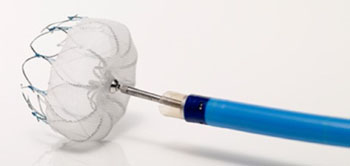Cardiac Closure Device Reduces Stroke Risk
By HospiMedica International staff writers
Posted on 06 Apr 2015
An innovative left atrial appendage (LAA) closure device assists high-risk patients with non-valvular atrial fibrillation (AF) who are seeking an alternative to long-term warfarin therapy. Posted on 06 Apr 2015
The Watchman LAA closure system consists of a delivery catheter, an access sheath that serves as a conduit for the delivery catheter, and the LAA closure device itself, which is permanently implanted at or slightly distal to the ostium of the LAA, blocking it off to prevent thrombus embolization. The Watchman LAA is made of a nitinol frame with a polyethylene terephthalate (PET) membrane cap, and is available in five diameters (21, 24, 27, 30, and 33 mm); 10 active fixation anchors provide stability and retention. The access sheath is available in either a double or single curve distal tip.

Image: The Watchman LAA closure device (Photo courtesy of Boston Scientific).
A transesophageal echocardiogram (TEE) is first performed to determine device size. The placement procedure is performed in a catheterization laboratory, using standard transseptal technique. Once the inter-atrial septum is crossed, the access sheath is advanced over a guidewire into the left atrium and onto the distal portion of the LAA over a pigtail catheter. The Watchman is then advanced under fluoroscopic guidance and deployed into the LAA. The Watchman LAA closure device is a product of Boston Scientific (Natick, MA, USA), and has been approved by the US Food and Drug Administration (FDA).
“Boston Scientific is proud to offer this potentially life-changing stroke risk treatment option to high-risk patients with AF who have a reason to seek a non-drug alternative to warfarin,” said Joe Fitzgerald, executive vice president and president of rhythm management at Boston Scientific. “FDA approval of the Watchman device is another example of Boston Scientific delivering on its commitment to bring meaningful innovations to patient care.”
“The Watchman device is a breakthrough treatment providing those patients who are suitable for warfarin with an implant-based alternative to long-term warfarin therapy while still reducing the risk of stroke,” said Vivek Reddy, MD, director of the cardiac arrhythmia service at Mount Sinai Medical Center (Miami, FL, USA). “We know that up to 40% of patients who are eligible for oral anticoagulation do not take it for numerous reasons, highlighting the need for additional treatment options.”
The LAA is a small, ear-shaped sac in the muscle wall of the left atrium. In normal hearts, the heart contracts with each heartbeat, and the blood in the left atrium and LAA is squeezed out into the left ventricle. When a patient has AF, the chaotic impulses do not give the atria time to contract, and blood collects and can form clots in the LAA and atria. The LAA is thought to be the source of more than 90% of stroke-causing blood clots that come from the heart in non-valvular AF patients.
Related Links:
Boston Scientific
Mount Sinai Medical Center













.jpg)
